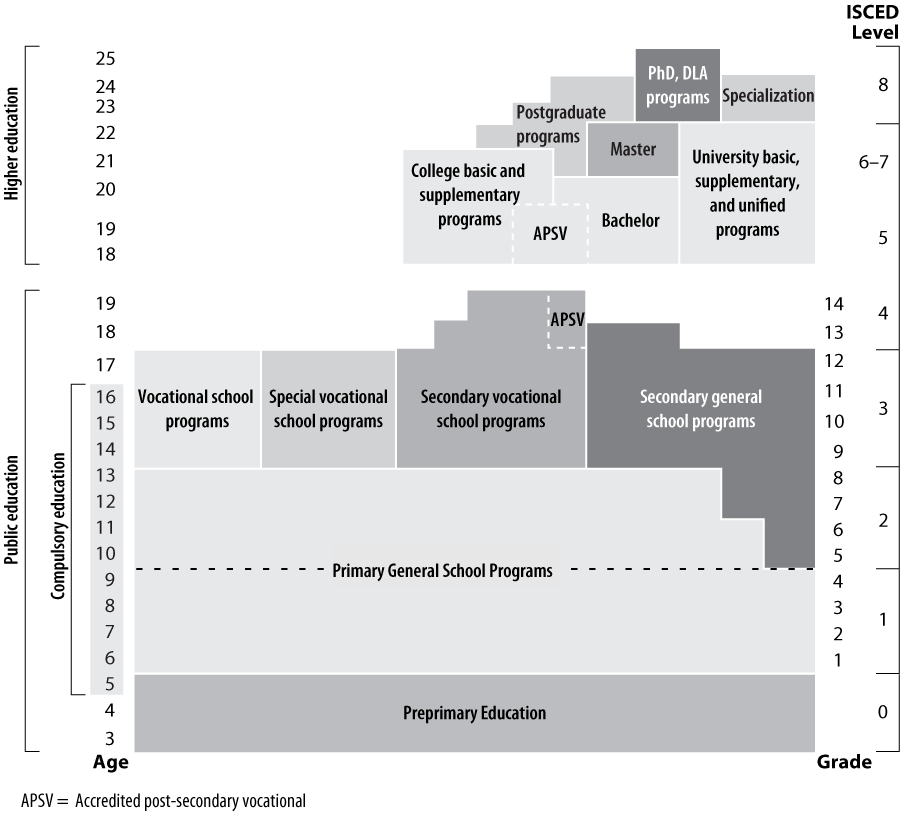László Ostorics
Balázs Szalay
Ildikó Szepesi
Klára Veresné Jakab
Department of Educational Assessment and Evaluation
Educational Authority
Overview of Education System
According to Act CXC of 2011 on National Public Education,1 the state ensures the provision of public education, with the exception of preschools. The state provides public education by establishing and operating institutions and by working with churches or private institutions through public education agreements. Local governments ensure the provision of preschool education by establishing and operating institutions or by means of public education agreements.
The state is authorized to regulate the introduction and implementation of the national curriculum. Public education institutions are professionally independent—they make decisions regarding their own organization and operation on matters not regulated legally by any other entity.
Exhibit 1 presents the structure of the Hungarian education system by age, grade, and ISCED 2011 level.2
Exhibit 1: The Structure of the Hungarian Public Education and Higher Education System by Age, Grade, and ISCED Level

Crèche (nursery) is a noncompulsory welfare institution serving children ages 20 weeks to 3 years, providing professional day care and fostering child development. As of September 2015, preprimary education is compulsory for children ages 3 to 6. Prior to this, enrollment was mandatory at age 5, although children generally were enrolled in preprimary education at age 3.
Elementary education is organized as a single-structure system in eight-grade primary schools (typically for students ages 6 to 14, Grades 1 to 8). Secondary education (typically for students ages 14 to 18, Grades 9 to 12) is provided by secondary general schools, secondary vocational schools, or vocational and special vocational schools. Secondary general schools also are allowed to offer longer programs starting earlier (from Grade 5 or 7). Some four year grammar and secondary vocational schools offer a preparatory first year, during which students focus on foreign language learning supplemented with mother tongue and mathematics lessons before starting the four year program, thus adding one year to the typical four year program of study.
Secondary general schools provide general education and prepare students for the secondary school leaving examination, which is a prerequisite for admission to higher education. Secondary vocational schools provide general and prevocational education, prepare students for the secondary school leaving examination, and offer vocational post-secondary, nontertiary programs. Vocational schools provide general, prevocational, and vocational education, and also may provide remedial lower secondary general education for students who have not completed basic education.
Higher education programs are offered by public or private universities and colleges (nonuniversity higher education institutions). In accordance with the three cycle Bologna degree structure, there are bachelor’s degree programs lasting six to eight semesters, which may be followed by master’s degree programs lasting another two to four semesters. The third cycle of higher education comprises doctoral studies. There also are continuous long programs.3
Languages of Instruction
Hungarian is the official language of Hungary and the official language of instruction in schools, but a number of ethnic and national minorities have minority educational institutions with their own languages as the first or second language of instruction at the primary and secondary levels (e.g., Croatian, German, Romanian, Serbian, Slovak, Slovenian, Polish, Greek, or Roma may be the first or second language of instruction).
Additional minority education classes may be organized when there are at least eight parents of a minority group in a settlement whose mother tongue is not Hungarian. If the number of children is insufficient, parents may request that the local government organize mother tongue and culture classes in connection with school education. These classes may be operated by a department within the school, by a separate language school, or by traveling teachers for hire. Minority education classes have been taught in Bulgarian, Roma, Greek, Croatian, German, Romanian, Ruthenian, Serbian, Slovak, and Slovenian.
